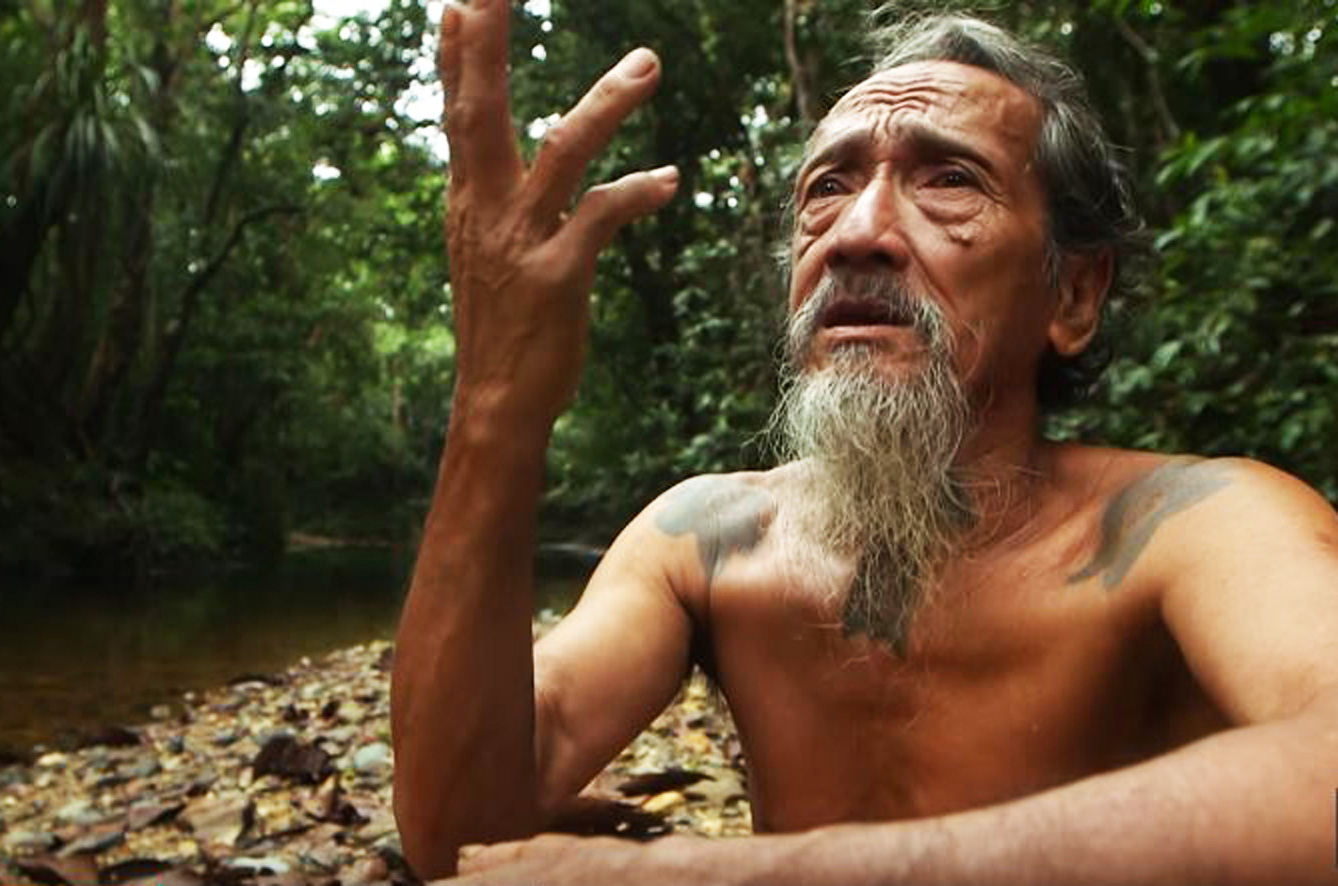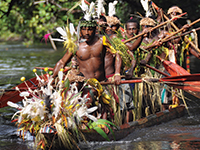View on The Global Environmental Justice site
Curator and writers
This film was selected by Amity Doolittle, senior lecturer and research scientist at the Yale School of Forestry and Environmental Studies. The guide was written by Caleb Northrop and Liz Felker, graduate students at the Yale School of Forestry and Environmental Studies.
Why we chose this film
This film is told from the perspective of individuals and communities who have been affected by environmental injustices. Because it’s not an outside analysis, it allows for lived experiences to be described in personal and culturally important ways. While the film highlights the fact that indigenous groups are consistently facing multiple types of environmental hazards that threaten their land, sovereignty, and cultures, Homeland also provides hope. It shows that power resides in these communities. Through careful organizing, creative tactics, and a deep connection to and relationship with nature, even small groups and communities can put up a fight against powerful state and corporate forces to demand environmental justice.
Teacher's guide
Please see the teacher's guide for maps, background information and suggested subjects, questions and activities.
Synopsis
* Gail Small, an attorney from the Northern Cheyenne nation in Montana, is leading the fight to protect the Cheyenne homeland from 75,000 proposed methane gas wells that pollute the water and threaten to make much of the reservation unsuitable for farming or ranching.
* Evon Peter is the former chief of an isolated Alaska community of Gwich'in people who are working against current efforts to drill for oil in the Arctic National Wildlife Refuge.
* Mitchell and Rita Capitan founded an organization of Eastern Navajo people in New Mexico whose only source of drinking water is threatened by proposed uranium mining.
* Barry Dana, the former chief of the Penobscot Nation in Maine, is battling state government and the paper companies that have left his people unable to fish or swim in or harvest medicinal plants from the river on which they have depended for 10,000 years.
In the midst of these struggles the particpants in homeland mange to present a vision of how people around the world can turn around the destructive policies of thoughtless resource plundering and create a new paradigm in which people can live healthier lives with greater understanding of, and respect for, the planet and all of its inhabitants.
The environmental justice focus of the film
As these four stories demonstrate, environmental justice is multifaceted: it includes distributive justice, recognition justice, procedural justice, and compensatory justice. In each story, corporations are profiting from resource extraction at a substantial cost to the environment and to the Native American communities. In each case, federal and state governments have prioritized profit over environmental health and the ultimate survival of these Native American communities. But in each case, the communities have proven to be a wellspring of strength and resistance.
"There's ample evidence to suggest that [tribal peoples'] causes are anything but hopeless, and despite daunting odds, there's undeniable unity and nobility among the Native American groups who are profiled. Recommended." -Video Librarian “Beautifully crafted. Stunning.” – VARIETY
"Homeland is a poignant and powerful portrait of how corporate power and government complicity are ruining our precious land,air, water. It is a troubling film, but also inspiring, because it shows Indians, who are the best guardians of the natural environment, fighting back against great odds, and refusing to give up." -- Howard Zinn, "A People's History of the United States"
"Elegant... finds and celebrates the vibrant spiritual bonds that unite its central characters... Astonishingly good cinematography." -- David Templeton, The Bohemian. "Homeland... represents the very best in documentaries being produced in the US today.” -- Berkeley Video & Film Festival
"A compelling, in-depth look at the environmental pressures that Native American reservations across the country are currently facing." -- Jenny Shank, New West Magazine
Review by Ally Ham for Video Librarian Four stars ****
https://videolibrarian.com/reviews/documentary/homeland-four-portraits-of-native-action-documentary/
Homeland: Four Portraits of Native Action provides a valuable focal point for discussions on environmental justice for Indigenous American communities. This educational documentary and its teacher’s guide would be valuable teaching tools.
Director Roberta Grossman’s educational documentary Homeland may have been released in 2005, but its document of Native resistance against environmental hazards is today more relevant than ever. At the time of writing, the Biden administration is preparing to make a decision on whether to approve the Willow project, an oil drilling undertaking that would have massive environmental effects for Alaska Natives. In Homeland: Four Portraits of Native Action, Grossman is concerned with a history of similar projects that endanger the health of Indigenous people.
Through journeys to four different Native American tribes, she compiles a wealth of information on environmental dangers to Indigenous American communities, from oil drilling to nuclear contamination. Additionally, a teacher’s guide from Global Environmental Justice Documentaries provides helpful supplementary material to the documentary, including more recent resources detailing how Indigenous tribes are still struggling to protect their food, water, and land from (literally) toxic industrial enterprises.
At the Northern Cheyenne Indian Reservation in Montana, the U.S. government perpetuates a history of oppression against the Cheyenne nation. Attorney Gail Small details for us how the government, driven by the desire for fossil fuels, drills on the borders of the Indian reservation. They then dump the coal-bed methane water, contaminating the Northern Cheyenne’s water supply. “There’s a tremendous spiritual connection to our homeland that is the core of the fight here,” Small says. It’s a connection that’s repeatedly threatened by environmental hazards created by the very government that’s meant to protect them. But it’s a connection that’s held together by the Northern Cheyenne’s bond to each other and to the land.
From Montana, the educational documentary takes us to Alaska, where Chief Evon Peter of the Gwich'in tribe organizes resistance against oil companies that would threaten their land and caribou. And in New Mexico, a Navajo reservation is still feeling the harmful effects of the history of uranium mining on their land. They are nearly swayed to welcome the industry back, but Navajo activists Mitchell and Rita Capitan start a grassroots campaign to protect their community from the uranium industry. There are threads of resistance against governmental oppression and environmental hazards connecting all three of these stories, but Grossman’s thesis doesn’t fully take shape until Homeland’s last segment.
At the Penobscot Nation in Maine, former chief Barry Dana honors his people’s sacred connection to their waters. But a nearby paper mill disrespects the sacred river, contaminating the water with the toxic chemical dioxin. Dana and Penobscot supporters recognize the environmental racism and consumerism at the heart of this issue, and these observations shed new light on the educational documentary’s preceding segments.
If at first these Indigenous stories of resistance feel repetitive, the cyclical nature of the educational documentary ultimately strengthens its cutting message. A plurality of voices, including environmentalist Winona LaDuke, and their shared experiences reinforce the cyclical, unrelenting nature of environmental oppression on Native lands–and in equal measure the unwavering nature of Native resistance. Homeland cleverly builds on this presentation to pose a challenge to the country. “In reality,” LaDuke states, “our reality is your reality.” Government action and environmental hazards pose a threat to us all. But the Indigenous people of America have never been able to turn a blind eye. Homeland is highly recommended for your library collection.
What academic subjects would this film be suitable for?
This educational documentary and its teacher’s guide would be valuable teaching tools for academic subjects such as environmental studies, activism and human rights, and Indigenous studies.
How does this film contribute to a discussion of environmental or climate justice?
Homeland: Four Portraits of Native Action provides a valuable focal point for discussions on environmental justice for Indigenous American communities. Grossman ties four stories of Native resistance together to indict the U.S. government’s lack of environmental protections for Native Americans.
What type of library programming could use this title?
Library environmental programs can utilize Homeland for educational screenings about Native action against targeted environmental hazards.




